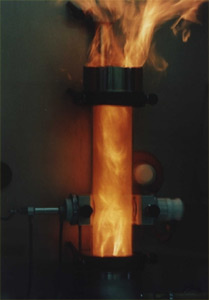Using a spark with controllable energy content, the minimum ignition energy (MOE) of the powder is determined in the MIKE3 device. The energy levels tested are 1000, 300, 100, 30, 10, 3 and 1 mJ.
Energie minimale d'inflammation
It is well known that explosible dust clouds can be ignited by electric sparks and arcs that occur in switches and motors, and in short-circuiting caused by damaged cables. In addition, some categories of electrostatic discharges may initiate dust explosions in industry.
For an assessment of the hazard situation in dust-processing installations, knowledge of the minimum ignition energy is indispensable. This value can possibly determine the extent and hence the cost of protective measures.
A modified Hartmann-tube made of glass with a volume of 1.2 litre is used as the explosion vessel. The dust dispersion system at the base of the tube is of the "mushroom-shaped" type around which the sample is loosely scattered. A blast of compressed air at 7 bar is used to disperse the dust in the glass cylinder where it is ignited by a spark between two electrodes. The energy just sufficient to ignite the dust under investigation is determined. This ignition energy is then successively reduced with variation of the dust concentration and the ignition delay time (turbulence) in a series of tests until no ignition takes place in at least 10 successive experiments.
The minimum ignition energy (MIE) lies between the lowest energy value (E2) at which ignition occurred and the energy (E1) at which in at least 10 successive experiments no ignition was observed. The energy range thus determined is called the minimum ignition energy of a combustible dust in admixture with air. However, for purposes of simplification often only the lower limit value (E1) is specified as the minimum ignition energy (MIE): E1 < MIE < E2. By definition, MIE data refer to protracted capacitor discharges. These are generally more incendive than purely capacitive discharges. The results obtained under such conditions (with inductance) can be applied to operational conditions only if the capacitors occuring in plant installations ara also discharged via an inductance. Hence, if the incendivity of electrical discharges - especially of electrostatic discharges - with regard to dust/air mixtures is to be assessed, the minimum ignition energy must also be determined without an inductance in the discharge circuit. Therefore tests can be performed both with an inductance (of 1 mH) as without inductance.
The test is normally performed on the fraction of the powder with a particle size < 63 micron.
- EN 13821: Potentially explosive atmospheres – Explosion prevention and protection – Determination of minimum ignition energy of dust/air mixtures
- EN ISO/IEC 80079-20-2:2016: Explosive atmospheres Part 20-2: Material characteristics – Combustible dusts test methods, Section 8.2
- VDI-Richtlinien 2263, Blatt 1: Untersuchungsmethoden zur Ermittlung von sicherheitstechnischen Kenngrössen von Stäuben (1990)
- Kühner AG, MIKE 3: Minimum ignition energy
- W. Bartknecht, Staub Explosionen: Ablauf und Schutzmassnahmen (1987)
- R.K. Eckhoff, Dust explosions in the process industries (1997)
- Handboek explosiebeveiliging, Kluwer-Editorial

